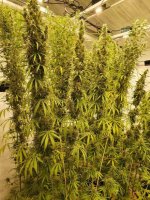Hello fellow ACErs,
Hope all of you are well and have good start of new season
After 3 years of struggle I finally realized 20-25l amended living soil is definitely not enough for 150-180cm mainlined sativa plants (they constantly got rootbound at 8-12 weeks of flowering). Planning to switch from autopots to aquavalve feeded custom raised beds (please, read automatic bottom feed hempy raised bed here) - 300L of living soil for each group of 4 plants. As usual, already read hundreds of thematic posts but still got some questions asking for answers
1) Is there a real need to topdress if I put enough nutrients in starting soil mix assuming I have 75L of soil per indoor plant?
2) Had someone already tried to experiment mixing standard and slow release dry organic fertilizers and amendements in flower beds for long flowering sativas? Plan to use Biotabs + Dr. Earth + Jobes Organic's Organic Fert Sticks for container plants along with base soil mix. Trying to be smartass here to avoid topdressing during flowering I feed from bottom, topdressing works a bit differently with Autopots and Aquavalve, at least for me...
I feed from bottom, topdressing works a bit differently with Autopots and Aquavalve, at least for me...
3) Some tips for height control without ability to make plant root-bound?
4) Any other essential tip or point for growing in raised beds I'm totally missing?
Cheers!
P.S. I'm pretty sure Benoit or any of you guys rocking with Autopots would be of great help here
Hope all of you are well and have good start of new season
After 3 years of struggle I finally realized 20-25l amended living soil is definitely not enough for 150-180cm mainlined sativa plants (they constantly got rootbound at 8-12 weeks of flowering). Planning to switch from autopots to aquavalve feeded custom raised beds (please, read automatic bottom feed hempy raised bed here) - 300L of living soil for each group of 4 plants. As usual, already read hundreds of thematic posts but still got some questions asking for answers
1) Is there a real need to topdress if I put enough nutrients in starting soil mix assuming I have 75L of soil per indoor plant?
2) Had someone already tried to experiment mixing standard and slow release dry organic fertilizers and amendements in flower beds for long flowering sativas? Plan to use Biotabs + Dr. Earth + Jobes Organic's Organic Fert Sticks for container plants along with base soil mix. Trying to be smartass here to avoid topdressing during flowering
3) Some tips for height control without ability to make plant root-bound?
4) Any other essential tip or point for growing in raised beds I'm totally missing?
Cheers!
P.S. I'm pretty sure Benoit or any of you guys rocking with Autopots would be of great help here


 ). Main idea is to get as 'water-only' as possible (true water only ideally), but found out you can't go water-only with 20-25L (5-7 gallon) pots when you grow large animals. That's why I'm switching to flower beds with 300-350l (80-90 gsllons) for just 4 plants.
). Main idea is to get as 'water-only' as possible (true water only ideally), but found out you can't go water-only with 20-25L (5-7 gallon) pots when you grow large animals. That's why I'm switching to flower beds with 300-350l (80-90 gsllons) for just 4 plants. . I hope it can be clearly seen in attached pic.
. I hope it can be clearly seen in attached pic. 

